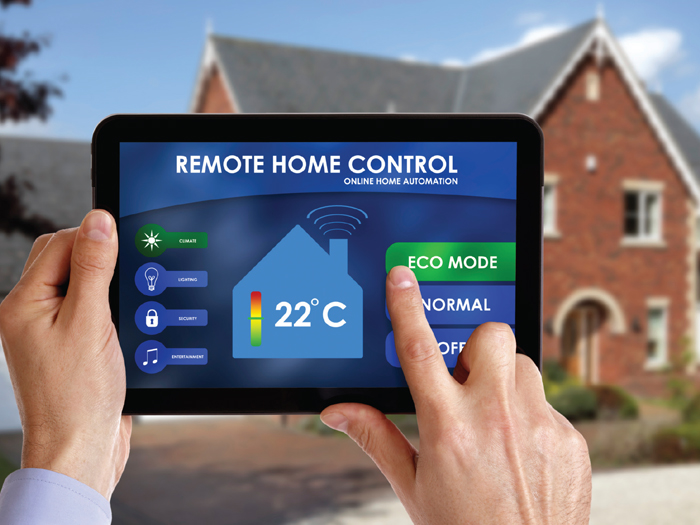The Internet of Things
Connected to Custom Coverage

Seismic changes are afoot in the insurance world with new technological developments stemming from the rush to the Internet of Things (IoT).
According to a report from McKinsey Global Institute, IoT has the potential to unleash as much as $6.2 trillion in new global economic value annually by 2025.
But what value will it bring to the insurance industry and, more specifically, to their customers? Let’s take a look at a few common areas of insurance — automotive, health benefits and commercial real estate — and see what the future holds.
Connected Cars
Do you have the same driving patterns as your friends, family and colleagues? It’s highly unlikely, but until now, you’ve had no choice but to pay the same rates and premiums, based on the average risk level. If you are a safer than average driver, you end up paying to cover those at greater risk. Is it fair and is this the best system we can have?
One in five new cars already collect driver and driving data for car manufacturers, but the future of the connected car will allow consumers to manage their individual automotive policies from the comfort of their driver seats.
Automotive dealers will be able to team up with insurance companies to provide data on driving habits and behaviors such as acceleration and taking corners too harshly via embedded sensors, and assign highly personalized risk scores.
But take this another step into the future and picture your car connecting to your Facebook. According to Ovum, insurers should focus on creative initiatives that analyze data from a number of sources, including social media and machine-to-machine communications.
If your car could sort through your contacts and match your driving profile (developed by the embedded sensors) to other people with similar driving profiles then you could band together to buy insurance as a group. For this example’s sake, imagine that you’re the picture-perfect driver with zero black marks on your record and your car has grouped you with other spotless drivers.
Your group of safe drivers can now buy insurance for a much lower premium and will qualify for a massive safe driver discount. Will connected cars be the ticket to replacing individual or company policies?
Driving Like a Girl
You may read this and think I’m being sexist, but the insurance industry has notoriously charged teenage male drivers much higher premiums than their female counterparts. In 2012, however, the European Court of Justice passed the “EU Gender Directive” that stated men and women must be offered the same quote if their circumstances are otherwise identical.
In response, Drive Like a Girl, a UK-based, telematics car insurer, has used little black boxes to record driving behaviors and discern whether a driver is driving with the profile of a 17-year-old girl regardless of age, gender, occupation, etc.
Video: Wireless Car describes the wide-ranging benefits of telematics to both drivers, manufacturers and businesses.
Telematics allows an insurer to provide lower rates accordingly. So, you don’t actually have to be a 17-year-old girl to catch a break on your insurance; you just have to drive like one!
The EU ruling is only one factor fueling the massive growth of global insurance telematics subscriptions, expected to grow 81 percent from 5.5 million at the end of 2013, to 107 million in 2018. More consumers want to take insurance underwriting into their own hands.
The United States doesn’t have a similar ruling on the books yet, but some companies, such as Progressive, are relying on the technology.
More than one million drivers have chosen to install that company’s device under the wheel, which allows Progressive to analyze individual driving habits and track projected savings, allowing a totally personalized rate for the driver.
The emergence of mobile apps and enhanced customer experiences through the use of technology in order to improve customer retention are additional reasons for this growth.
Impact on Health
Wearable devices such as smart watches or wristbands allow employees and consumers to say, and prove, that their lifestyles are low-risk. Fitness junkies and professional athletes are already commonly using this technology to monitor heart rate, stress levels, sleep schedules and calories burned.
But the next logical step is to use these devices to qualify for better employee health insurance or personal health insurance discounts.
Video: Some employees at Atlantic Corp. talk about the health changes they have experienced since wearing Fitbit.
According to research from the Henry J. Kaiser Family Foundation and the American Hospital Association’s Health Research and Educational Trust, the cost of employee health insurance is still increasing faster than wages and overall inflation.
Currently, the average price for a single worker is $6,025 and the average annual premium for a family plan rose to $16,834. But with the Affordable Care Act’s higher costs for employers, we will begin to see more companies turning to wearable devices to help them monitor their employee’s health in the near future.
In order to combat costs, wearables will be given to employees, and incentive programs will be created to encourage their use.
For example, British Petroleum handed out Fitbit Zip devices to about 14,000 employees in 2013. If employees took one million steps, they received points that qualified them for lower insurance premiums.
In fact, Fitbit reports that sales to companies are one of the fastest growing segments of its customer base. We may need to establish a new technology acronym to replace BYOD — perhaps BYOW will take off in 2015?
The technology can also usher in crowdsourcing for personal health insurance as well — there is undeniably more buying power with 1,000 individuals than just one person.
Perhaps this will even open the door to pet insurance as well given new wearables designed specifically for man’s best friend continue to roll out. And what does the insurance industry love more than the ability to break into niche markets? Insurance companies can use this technology to target low-risk opportunities to drive a better return and greater volumes.
Automatic Adjustments
The advent of smart commercial buildings will eliminate the need for building managers to total a stated insurable value by listing everything on its premises.
With a smart building monitoring itself and updating its central system in real time, the building can tell an insurer that its risk profile this afternoon is at at a lower risk than it was just yesterday.
Instead, property premiums can be automatically tallied by connecting the insurance company to the building’s central smart hub, which houses all of the data such as air quality and temperature.
Access to security systems, sprinklers, and disaster recovery plans in one location provides a much crisper insurance profile than just relying on raw building and cost data.
With a smart building monitoring itself and updating its central system in real time, the building can tell an insurer that its risk profile this afternoon is at at a lower risk than it was just yesterday.
Rather than replacing an annual policy or going through the hassle of a three year deal, policies can be adjusted daily.
As such, building owners could qualify for better insurance premiums by providing a historical view of building trends. There are also benefits aside from cost savings.
For example, say you own a building in Miami. You can match and profile your hurricane risk by the minute and remediate high-risk issues very quickly. Additionally, the need to hire field evaluators to do this process manually is eliminated.
Thanks to the advancements taking place within the IoT, shopping for insurance of any sort will be akin to shopping for new clothes.
It won’t be a cumbersome process where you are purchasing retrofitted policies that don’t seem to match. It will be a sleek and automated experience where policies will be developed to fit individual needs.
We’re entering an insurance era where consumers and companies are empowered and we all should be ready for it.











